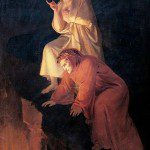John 4:34 also introduces three standard ways by which Jesus will frequently describe his relationship with the Father: "My food is to do the will of him who sent me and to accomplish his work." Throughout John:
- Jesus does the will of the Father (Jn. 4:34, 5:36, 6:38).
- Jesus does the work of the Father (Jn. 4:34, 5:36, 9:3-4, 10:25, 32, 37-38, 14:10, 17:4).
- Jesus has been sent by the Father (4:34, 5:23-4, 30, 37, 6:38-44, 7:16-33, 8:16-29, 9:4, 12:44-49, 13:20, 14:24, 15:21, 16:5).
I shall discuss the implications of these ideas in greater detail later.
The Second Sign: Jesus Heals the Official's Son (4:43-54)
The last section in chapter four deals with what John calls Jesus' "second sign" (sēmeion) (4:54), meaning the second miraculous act that demonstrates that Jesus is the Messiah. At one level it is a straightforward story. Jesus is traveling through Galilee and arrives at Cana, where a "royal official" (basilikos) from Capernaum meets him. The official begs Jesus to come to Capernaum to heal his son, but Jesus simply heals the son by speaking. The official and his household thereby believe in Jesus.
Unlike much of John, this story has parallels in the Synoptic Gospels (Mt. 8:5-13; Lk. 7:1-10), and it is possible that these are different accounts of the same event. In the Synoptics the story is about a "centurion" (hekatontarchos), a mid-level officer in the Roman army, in theory in command of one hundred men. The Greek term basilikos means literally a "royal person," which in theory could be a member of the Herodian royal family, but would more likely mean a royal official, and could refer to a centurion as an imperial officer.
This is the first of only three healing stories in John (Jn. 4:46-54, 5:1-15, 9:1-7). At its most basic level the point of the story is that Jesus can perform a miracle at a distance merely by willing it and speaking a word (4:50). Jesus, as God incarnate, has control over the entire created order (kosmos) because he created it by speaking words (Gen. 1). Jesus' miracles demonstrate control over the elements (wine into water, 2:1-11), natural forces (walking on water, 6:16-21), fertility and prosperity (feeding the multitude, 6:5-13), health (healing, 4:46-54, 5:1-15, 9:1-7), and life itself (raising Lazarus, 11:1-44). All these powers are attributed to YHWH in the Hebrew Bible.
John calls this Jesus' "second sign" (4:54), but in fact, it is his first public sign, since the miracle at Cana was done privately (2:9). These signs frequently result in belief that Jesus is the Messiah (1:50, 2:11, 23, 3:2, 4:48, 53, 6:14, 30, 7:31, 9:13, 11:45, 12:18, 20:30). Yet in this incident Jesus seems to chastise the people because "unless you (pl.) see signs and wonders (sēmeia kai terata) you (pl.) will not believe" (4:48).
This reflects the paradox of signs in John. Jesus performs public signs so that people might believe, but on the other hand proclaims, "blessed are those who have not seen and yet have believed" (Jn. 20:29). Indeed, Jesus tells the people that they should believe because of his works or signs (10:25, 37-38, 14:10-11). But, though signs may bring belief, signs alone are not sufficient, for though many see the same signs, some believe and some don't (5:38, 6:35, 64, 7:5, 48, 9:18, 10:25, 12:37, 39). In a sense, for John signs are crutches for those who lack the spiritual insight to recognize Jesus as the Messiah.
A pdf of the full version of this column, with extensive references and notes, can be found at:
http://byu.academia.edu/WilliamHamblin/Papers/448374/Exploration_of_John_4_27-54
Updates and discussion can be followed on Facebook at:
http://www.facebook.com/pages/An-Enigmatic-Mirror/180889785272535





